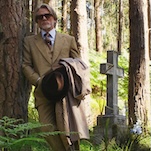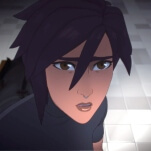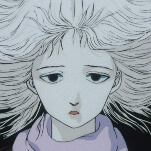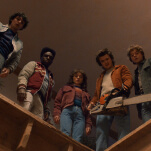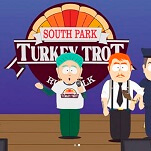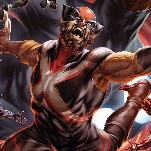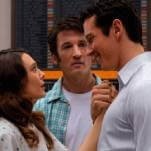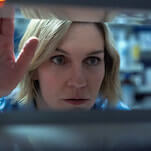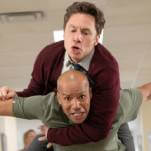This season of The Last Of Us has a lot on its mind. It’s a story of grief, revenge, love, parenthood, community, therapy, religion, cycles of violence, and, of course, what it’s like to survive in a post-apocalyptic world. Ideally, the show can balance all those ideas with some requisite action woven in too, like last week’s evocative hour, which, if anything, I think I underestimated in my recap. “Day One” has really lingered in my mind this past week, and I wouldn’t be surprised if it winds up being a high-watermark for season two.
Unfortunately, this week’s episode tries to recapture that same magic and mostly fails. At its best, this hour just repeats themes and ideas the show already covered last week—from Ellie picking up a guitar to our central duo debating whether or not Dina should turn back now that she’s pregnant. And at its worst it relies on logic leaps, plot contrivances, and fungal exposition in a way that feels overstuffed rather than well-balanced. Though there’s a certain scene-to-scene adrenaline rush to this tense, action-packed hour—particularly its unnerving ending—it’s all a bit clunkier than it should be.
That starts with a cold open that takes us back to an earlier point in Seattle’s timeline—after Isaac has defected from FEDRA but before the W.L.F./Seraphite conflict has elevated to the point it’s at today. W.L.F. leader Hanrahan (Alanna Ubach) shows up to interview Sergeant Park (Hettienne Park), who seems to have randomly killed a group of her own men. Only it turns out their deaths weren’t so random. While clearing out the basement levels of a hospital, the squad made the horrifying discovery that in the right dark and damp environment, the Cordyceps can make the virus airborne by producing “spores.” Breathe them in and you’ll turn into an infected, even if you haven’t been bitten. That’s why Park had to leave her squad sealed inside—including her son Leon.
For show-only watchers, this is a brand-new idea, but for gamers it’s a bit of a retcon. In the video game, the initial Cordyceps outbreak is spread through spores, rather than food, and the characters regularly have to wear gas masks to pass through infected areas. In the first season, creators Craig Mazin and Neil Druckmann decided to streamline things by making bites the primary mode of infection. But now they’ve decided to fold the spore iconography into the show too. Only I’m not sure the way they’ve chosen to introduce the idea makes much sense.
When Ellie first discovered a smart “stalker” in the season premiere, it was terrifying because it suggested the infected can continue to grow and evolve even two decades into the outbreak. But placing the spore reveal in a flashback suggests the outbreak has been operating like this for a while now and yet somehow none of our heroes have encountered spores in their various travels across the country.
True, the show is cagey about exactly when that flashback takes place—maybe it was during the five years Joel and Ellie were happily sequestered in Jackson. But “barricade the doors, leave the elevator shafts half open, and hope for the best” seems like a bananas way to contain an airborne virus. Despite the lip-service about how spores can’t travel through air vents, I still struggled to buy that the infection would stay so neatly sealed off as the Wolves set up Lakehill Hospital as one of their core bases. They’re literally living/working just a few floors above! And that’s the sort of logistical niggle that stopped me from truly getting sucked into the emotional roller-coaster of everything that happens this week.
Indeed, I can’t help but wonder if it would’ve been more impactful to use the cold open not to explain how spores work but to dramatize the story Dina tells about her childhood. Despite Ellie and Dina’s newfound intimacy, it’s remarkable how little the two actually know about each other—and how little we know about Dina as a result. Ellie hasn’t told Dina about Riley or the details of her immunity and the various times she’s been bitten. Dina, meanwhile, seemingly hasn’t told Ellie…anything about her life before Jackson? I get that people might not want to keep rehashing their traumas in a world filled with so much of it, but have they just been talking about Curtis And Viper films the past five years?
On the way to Lakehill Hospital, Dina finally reveals her full story: She grew up with her mom and sister in an isolated cabin in a forest north of Santa Fe. When she was eight years old, she went to play outside only to come home to a raider killing her family. She, in turn, shot him to death—marking the first time she killed someone. Dina calmly recites the story to prove she’s tough enough to continue the mission and to justify why she’s okay with getting vengeance no matter what Joel might have done in the past. But while I don’t need The Last Of Us to luxuriate in trauma, I do think it might have been more impactful to actually see Dina’s childhood and history with violence rather than just have her monologue about it.
As is, her speech is almost academic in its dissection of her motivations, which is something The Last Of Us is struggling with in this central revenge mission. On paper, the show is telling the story of two reckless, revenge-driven young women who are too focused on avenging Joel to think rationally. But, in practice, Dina and Ellie come across too cool, calm, and collected for that idea to land. They still get caught up in high-stakes “I love you”s and sweeping pre-battle kisses, but they’re self-aware about their own recklessness in a way that makes that recklessness less interesting to watch.
It doesn’t help that it feels like they’re allowed to be extra reckless because they both have a bit of plot armor on at the moment. Though there’s some great initial tension to their journey through a warehouse full of “smart” stalkers—particularly because of Dina’s ominous “if I die, it’s on me” line earlier—the set piece quickly crescendos to a level of chaos that actually deescalates the stakes. As the stalkers swarm, it becomes clear the only way either of them can survive in one piece would be via a deus ex machina, which is exactly what happens. Although the fact that the deus ex machina is Jesse does make me slightly more forgiving, just because I was so excited to see him again. (He and Tommy followed Ellie and Dina to Seattle once they realized they’d gone AOWL.)
Less exciting is the fact that every W.L.F. soldier Ellie, Dina, and Jesse encounter seems to have worse aim than a Stormtrooper. Earlier, Ellie suggests that the Wolves’ overconfidence is their weakness—which makes sense in terms of how they use their radio communication. But considering they’re at war with an enemy who likes to sneak into their buildings and disembowel them, I actually do think they’d be on heightened intruder alert at the moment. Instead, it’s actually the Seraphites who manage to get a shot in—landing an arrow in Dina’s leg that sends her and Jesse running for safety as Ellie continues on the mission alone.
If last week’s subway car chase felt video game-y in a fun way, this week’s third-act action feels more frustratingly contrived. That Ellie and Dina have now survived two impossible zombie scenarios over their two days in Seattle is a lot to swallow. That they accidentally run into Scar territory just in time to see a Seraphite priest ritualistically slice a guy open is convenient in its own way. And the fact that Ellie manages to escape the woods, break into the hospital, corner Abby’s ally Nora (Tati Gabrielle), and chase her through several hallways and floors without being stopped kind of just beggars belief.
Thanks to the dark lighting, it took me until a second viewing to fully understand the geography of the chase. Nora knows about the infected basement and is trying to climb through the elevator shaft to reach the doorway on the other side of the same floor. It’s only when the elevator falls and Ellie starts shooting that she runs into the spore-filled basement, potentially out of instinct or potentially to lure Ellie into an infection as well. (You can hear the soldiers upstairs shouting about the elevator shaft being open and needing to seal off the hallways, so it seems they’re all in Hanrahan’s “need to know” group.)
For Nora, the fact that Ellie is immune is a big reveal. But there’s a much bigger reveal in store for us. Though Nora tries to shock Ellie with the fact that Joel murdered all the Fireflies, it turns out Ellie already knows about her dad’s murder spree, which massively recontextualizes her season-long arc. Presumably when and how she learned that information will be at the center of next week’s flashback episode—and could potentially be the source of Ellie and Joel’s fracture from the premiere as well. But, for now, it’s a disturbing twist that Ellie knows just how much pain Joel inflicted on others and is still deadset on violently avenging him anyway.
With that context in place, it’s even more disturbing to watch Ellie pick up a rusty pipe and beat Nora with it—trying to torture out information about Abby’s location before Nora succumbs to the Cordyceps. Though Ellie spends much of this episode horrified at all the W.L.F./Seraphite violence around her in Seattle, she can’t see (or maybe just doesn’t care) that she’s part of the same kind of cycle of violence. In fact, Bella Ramsey plays the scene almost as if Ellie has dissociated from what she’s doing, like she’s literally transformed herself into Abby. The way the editing launches into a flashback of a happier memory with Joel (good to see you again, Pedro Pascal!) almost seems like her brain is taking her away from her violent present into a safe space she can hide.
It’s an effective tease for what I suspect will be quite an emotional hour next week. But it’s not enough to retroactively make this episode more successful. In a TV production era where it takes two years to produce a seven-episode season, it just doesn’t feel like there should be any need for filler episodes. But, unfortunately, too much of this hour veers toward that direction.
Stray observations
- • It’s interesting how Ellie and Dina hand off leadership duties. Dina is better at planning things out in advance, but Ellie is better in a crisis.
- • If you’re trying to hide out in a city full of crazy people, surely the last thing you’d want to do would be to turn on the lights in your hideout, right? Also why did Ellie and Dina leave their map in the theater rather than bringing it with them? Didn’t they need it to know where they’re going?
- • Shout-out to the Jackson hairdresser who gave Dina that impeccably layered haircut that’s been able to stay glossy through weeks of travel, several battles, and all that morning sickness.
- • In what really felt like a repeat of last week, Ellie finds another perfectly preserved guitar just waiting to be played. She strums the first line of Pearl Jam’s “Future Days,” but then finds herself too upset to continue.
- • Dina surmises that the Seraphites are basically the Amish of the apocalypse, although I still need way more information than that to understand their origins.
- • One of the spore-making infected Ellie finds in the basement is wearing the nametag “L. Park.” It’s an eerie reminder of how becoming infected can be a fate worse than death.
- • Surely there’s more than one hospital in Seattle, right? Couldn’t W.L.F. have set up in one that didn’t have spores in the basement? Maybe Grey Sloan Memorial from Grey’s Anatomy? Nothing bad ever happens there!
- • So where did Dina learn her triangulation skills?
- • “It’s haunted but empty.” / “Oh, just like us.”











